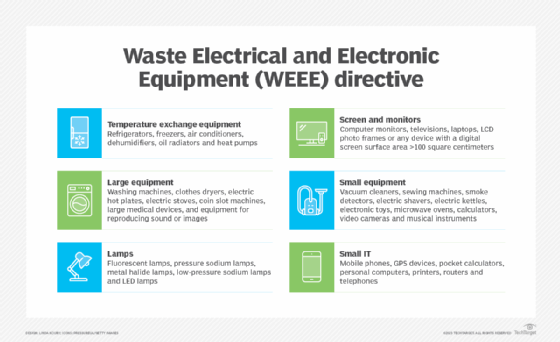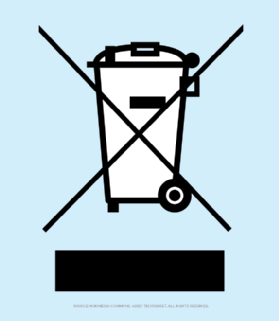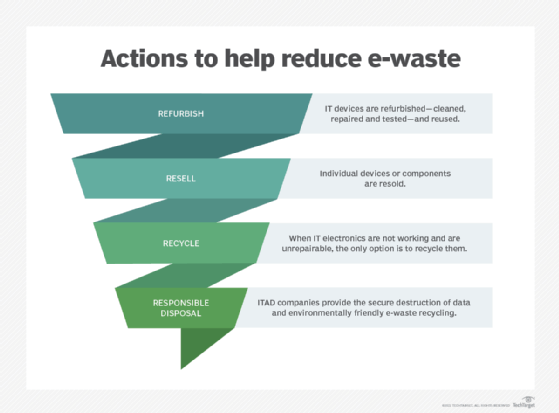Waste Electrical and Electronic Equipment (WEEE) Directive
What is the Waste Electrical and Electronic Equipment (WEEE) Directive?
The Waste Electrical and Electronic Equipment (WEEE) Directive is a legislative act that the European Union adopted to address the growing amounts of e-waste that come from electrical and electronic equipment (EEE) at the end of its life. The directive aims to improve the collection, treatment and recycling processes employed by EU member states in dealing with e-waste.
If improperly disposed, e-waste like old computers, mobile phones or kitchen appliances can pose environmental and health risks from exposure to lead, mercury and other hazardous materials. Electronic waste also contains rare and costly materials that can be recycled and reused.
The WEEE Directive is one of the EU's primary strategies for improving the sustainable production and consumption of EEE products. The directive attempts to limit the creation of e-waste, while encouraging more efficient resource usage and the recovery of raw materials. According to the European Commission, the WEEE Directive employs the following strategies to achieve these goals:
- Requires the separate collection and proper treatment of e-waste.
- Sets collection, recovery and recycling targets.
- Helps member states fight illegal waste exports by making it more difficult for exporters to disguise illegal shipments of e-waste.
- Reduces administrative overhead through the harmonization of national EEE registers and reporting formats.
The WEEE Directive is sometimes referred to as a regulation, but the EU distinguishes between regulations and directives. A regulation is a binding legislative act that is applied across the entire EU. A directive defines goals that EU members must achieve, but leaves it up to the individual countries to determine how to achieve those goals. As a directive, the WEEE legislation defines goals for dealing with e-waste and lets the member states decide how to meet their obligations.
In conjunction with the WEEE Directive, the EU also introduced the Restriction of Hazardous Substances (RoHS) in Electrical and Electronic Equipment Directive, which restricts the use of certain hazardous substances in EEE manufacturing. The RoHS Directive identifies 10 restricted substances, including lead, cadmium and mercury. As with the WEEE Directive, the RoHS Directive seeks to protect the environment and public health.

What equipment does the WEEE Directive cover?
The latest WEEE Directive took effect on February 14, 2014 and is officially known as Directive 2012/19/EU. It is a recast of Directive 2002/96/EC, the original WEEE law that governed how member states should handle e-waste. When the new WEEE Directive went into effect, the old one was repealed and replaced by the new one, which expanded the scope of the old directive.

The new directive defined a transitional period from August 13, 2012 through August 14, 2018 to provide member states with the time they needed to adopt the new goals. During the transitional period, the scope of the new directive was identical to the old directive except for the addition of photovoltaic solar power panels.
This changed on August 15, 2018 when the full directive went into effect, bringing with it more aggressive goals and expanded coverage. For example, the old directive applied only to specific types of EEE products, but the new directive applies to all e-waste, except what is specifically exempted in the directive. The directive now groups EEE products into six categories, rather than the original 10. Figure 2 shows examples of equipment in each category.
Most EEE products that are sold in EU states are now covered by the WEEE Directive, including products imported from other countries. Any equipment governed by the directive must bear the EU-approved marking, which is a crossed-out trash bin with a black bar beneath it, as shown in Figure 3. The black bar is required for all covered products that entered the market after August 13, 2005. However, manufacturers can instead specify the date that their products were placed on the market, rather than using the black bar.

Although the WEEE Directive covers most EEE, it also specifies that the following equipment is exempt:
- Security-related equipment used to protect the member states, as well as equipment designed for space.
- Equipment that is designed and installed as part of another type of equipment.
- Filament bulbs.
- Large-scale stationary industrial tools and fixed installations.
- Equipment that provides a means of transport, as well as non-road mobile machinery.
- Equipment used solely for research and development.
- Certain medical equipment, including in vitro devices.
The WEEE Directive covers most other types of EEE products. However, the directive is a complex piece of legislation, and it is up to the member states to determine how to achieve the directive's goals. As a result, implementation details can vary between countries. Vendors should be aware of the national WEEE legislation in each member state where they plan to distribute their products.
Learn all about environmental, social and governance (ESG), a framework used to assess business practices and performance on various sustainability and ethical issues. See why IT asset management should include sustainability. Explore 3 tips to reduce enterprise e-waste and 10 tips for a successful sustainability journey.






